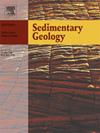Sedimentation patterns from turbidity currents associated to hydrodynamical transport modes
IF 2.9
2区 地球科学
Q1 GEOLOGY
引用次数: 0
Abstract
Turbidity currents are mechanisms that transport sediment from continental landscapes into coastal areas and therefore into oceans, reservoirs and lakes. Turbulence at the head of the turbidity current maintains sediment particles in suspension provided the mixing is greater than the settling velocity of the particles being transported. However, both the depositional regimes of the particles in turbidity currents and the extent of the hydrodynamical regimes still need to be better related. Likewise, the associated sedimentary patterns need to be related to the type of particles that form a turbidity current. In this study, a set of lock-exchange experiments in a flume were conducted to determine the extent and development of a turbidity current composed of different granulometric sediments and sediment concentrations. Both the extent of the inertial regime and the onset of the self-similar regime were determined and found to be dependent on the d50 of the sediment and the Rouse number (i.e. the balance between particle sedimentation and mixing due to the gravity current development). The results obtained from the sedimentation patterns bring new knowledge in explaining the gradation of sediments in turbidites and its relationship to the longitudinal hydrodynamics of a turbidity current as it develops.

与水动力输运模式相关的浊度流沉积模式
浊度流是将沉积物从大陆景观输送到沿海地区,从而进入海洋、水库和湖泊的机制。如果混合速度大于被输送颗粒的沉降速度,浊流头部的湍流将使泥沙颗粒保持悬浮状态。然而,浊流中颗粒的沉积制度和水动力制度的程度仍然需要更好地联系起来。同样,相关的沉积模式需要与形成浊度流的颗粒类型有关。本研究在水槽中进行了一组锁交换实验,以确定由不同粒度沉积物和沉积物浓度组成的浊度流的程度和发展。确定了惯性状态的范围和自相似状态的开始,并发现它们取决于沉积物的d50和劳斯数(即由于重力流发展而导致的颗粒沉积和混合之间的平衡)。从沉积模式中获得的结果为解释浊积岩中沉积物的级配及其与浊流发展时纵向流体动力学的关系带来了新的知识。
本文章由计算机程序翻译,如有差异,请以英文原文为准。
求助全文
约1分钟内获得全文
求助全文
来源期刊

Sedimentary Geology
地学-地质学
CiteScore
5.10
自引率
7.10%
发文量
133
审稿时长
32 days
期刊介绍:
Sedimentary Geology is a journal that rapidly publishes high quality, original research and review papers that cover all aspects of sediments and sedimentary rocks at all spatial and temporal scales. Submitted papers must make a significant contribution to the field of study and must place the research in a broad context, so that it is of interest to the diverse, international readership of the journal. Papers that are largely descriptive in nature, of limited scope or local geographical significance, or based on limited data will not be considered for publication.
 求助内容:
求助内容: 应助结果提醒方式:
应助结果提醒方式:


